WRAL Television Channel 5, Raleigh, N.C.
The Raleigh landmark seen here has not changed much since it was built in 1959, but the communications medium for which it was built, has. This week Flashback Friday stops by the WRAL-TV studios on Western Boulevard.
WRAL-Television
Channel 5 Â NBC
2619 Western Boulevard
Raleigh, N.C.
No message this week!
Goodnight Raleigh visited the WRAL Studios in a previous post five years ago in which we explored the architecture of this familiar modernist treasure. This week, we’ll take a closer look at the origins and legacy of WRAL-TV itself.
“Eagle Against the Sun” by sculptor Chris Navarro graces the forecourt of the WRAL-TV studios on Western Boulevard.
Bringing Together Capitol Broadcasting Company and WRAL-TV
In 1937, Raleigh lawyer and businessman, A.J. Fletcher, applied for a 250-watt AM radio station and formed Capitol Broadcasting Company. Thus, WRAL-AM went on the air in 1939, the second commercial radio station to broadcast from Raleigh. The first was WPTF, which had begun operation in 1927.
In the decade following WW II television emerged as the major broadcasting medium in Raleigh. WNAO-TV was Raleigh’s first TV station, airing July 13, 1953. It was owned by The News & Observer, which also owned WNAO Radio (1949). Durham’s WTVD television station began broadcasting in September 1954, and Raleigh’s second TV station, WRAL, as an NBC affiliate, aired its first programs from a tiny cinder block building located on US 70 on December 15, 1956.
This photo shows the base of WRAL-TV’s 1,170-foot transmission tower and its modest studio building in 1956. Below is the sign erected alongside the highway announcing WRAL’s television presence in Raleigh.
A Modern Building for a Modern Era
Almost immediately after its conception, Capitol Broadcasting Co. sought to erect a suitable building to house its new television station. A.J. Fletcher selected G. Milton Small as his architect. The main building closely resembles his former office at the corner of Brooks Ave. and Hillsborough St. Designed in partnership with Joseph Boaz, the new WRAL offices were completed in 1959.
This view of the new WRAL-TV studios appears to be a black and white version of the photo used to produce this week’s postcard.
As a complement to his modernist studio building, A.J. Fletcher commissioned the creation of WRAL’s renowned Azalea Gardens. This verdant urban refuge lies behind the main buildings at the Western Blvd. site.  The gardens opened to the public in 1959, simultaneously with the television studio complex itself.
Located behind WRAL-TV studios, the Azalea Gardens are open to the public, and are available as a venue for weddings and other private functions.
WRAL-TV’s Lasting Mark on Raleigh
WRAL was a pioneer in local television broadcasting. Among its other initiatives, and owing to the its largely rural audience in the 1950s and 1960s, the station was one of the first in North Carolina to cover agricultural markets and farm news in its regular newscasts. “The Farm Report” was hosted for two decades by agriculture correspondent Ray Wilkinson on the noon newscast.
Among WRAL’s beloved early news personalities were Bob Debardelaben, the station’s inimitable ‘weather man’, Ray Reeve at the sports desk, and Charlie Gaddy, senior news anchor for many years.
WRAL also aired its own studio productions in the early years. These included an afternoon children’s show, Cap’n Five, starring Herb Marks. It ran 1958-1961, and was based in the fantasyland known as Happy Harbor.
And who could forget Time for Uncle Paul?  The show replaced Cap’n Five in 1961 and ran until 1981. It starred the locally renowned jazz pianist Paul Montgomery. Before Uncle Paul scored his own show, he appeared as Heinrich von Stuplebaum on the Cap’n Five show, on which he played the electric organ and entertained the children in the audience with his comedic airs.
Among other studio productions of that era was “Championship Wrestling,” which first aired in 1959, and ran for many years. Who doesn’t remember the theatrical antics of  Haystack Calhoun, the Masked Bolos, and Rick Flair as they faked their way through pugilistic set-ups?
In 1958 WRAL crossed the color barrier when it introduced J.D. Lewis as the host of the popular dance program “Teenage Frolics,” the station’s answer to Dick Clark’s American Bandstand . Lewis was a local African-American  radio personality who joined the WRAL team in 1948.
And of course, if you grew up in Raleigh in the 1960s, you will certainly remember Jesse Helms as the sometimes vitriolic host of  WRAL’s nightly news editorial segment, ‘Viewpoint’, which ran 1960-1972. Jesse’s editorials blended folksy anecdotes with conservative opinions that lambasted the federal government, the University of North Carolina at Chapel Hill and other entities he viewed as ‘too liberal’.
Throughout its early years WRAL-TV ‘signed off’ every night at midnight, playing the “Star Spangled Banner,” which was immediately followed by the ubiquitous geometric ‘test pattern’ before the TV screen went blank.
Nowadays, many years hence, some would say, WRAL-TV still reigns supreme over local television broadcasting; but, some others would say, sadly, that the likes of Bob Debardelaben, Cap’n Five, Uncle Paul, J.D. Lewis, Jesse Helms and Haystack Calhoun are long gone.
Our photochrome postcard this week was printed by Gillick Printing, Inc., of Berkeley, CA under the trademark ‘Spectra Color.’
Photochrome (aka Chrome)
In 1936 the development of new color inks, combined with the introduction of the first high quality, multi layered film, Kodachrome introduced process printing of color photographs. For the first time color-separated halftone negatives could be made for CYM (blue, yellow, red)Â hues with the aid of process cameras. When printed these three plates would render an image in better natural color than ever before. Black would be added to the pallet as a fourth color (CYMK), but it was not consistently used at first.
Postcards started to be produced through process printing almost immediately, but by the late 1940s photochromes were in high competition with linen cards and have monopolized production since the mid 1950s. These modern types of tricolor postcards that evolved from their earlier versions are now what is meant when referring to a photochrome or simply chrome for short. Their quality has increased over the years with advancements in film and offset lithography.
“Flashback Friday†is a weekly feature of Goodnight, Raleigh! in which we showcase vintage postcards depicting our historic capital city. We hope you enjoy this week end treat!
Â

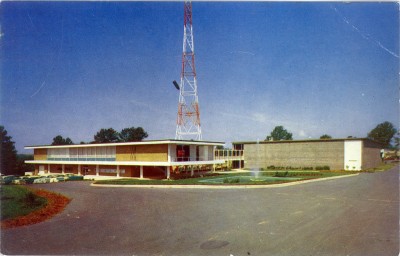
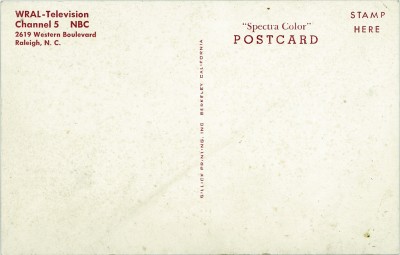
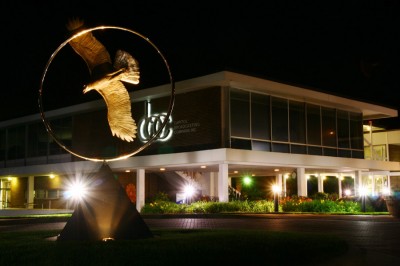
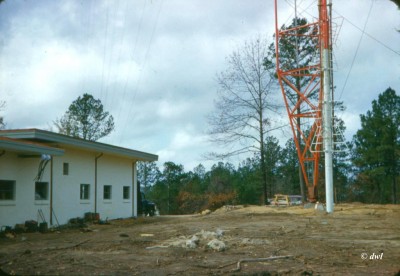
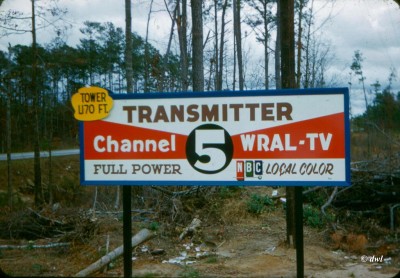
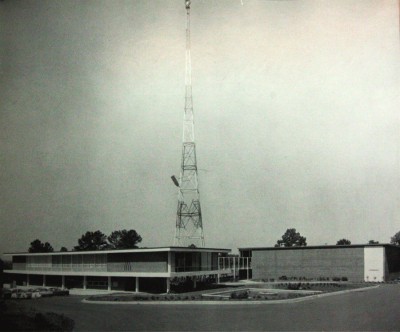

 Sign up for the Newsletter
Sign up for the Newsletter
06/20/2014
Wow, this really brings back some memories…rasslin’ and all.
06/21/2014
I vaguely remember a minature golf place adjacent to WRAL. Is that correct or just my imagination?
06/21/2014
It was a Putt-Putt. It later moved to Highway 70 (Glenwood Avenue) if I remember correctly.
06/22/2014
I remember that the station also played a very slow version of Dixie, while showing pretty Southern scenes. May have been when they signed off, but I think I remember it in the morning when they signed on. I would have been up early on Saturday morning to watch Flash Gordon and monster movies before the cartoons started (mid 1960’s?)
06/23/2014
If you want to see some old WRAL footage, NCSU digitized several short clips from WRAL-TV’s Farm news last year – the clips are mainly from the 1960s/1970s. They can be seen here: http://d.lib.ncsu.edu/collections/catalog?f%5Bnames_facet%5D%5B%5D=WRAL-TV
03/10/2015
My father-in-law Joe Cutter was a news anchor/weatherman for WNAO in the 1950s, I am trying to locate old clips, photos or newspaper articles or anything you might have in your archives. I am working on his history for his grandchildren. Is any of it available on-line to view? Or were there any great broadcasts that could be duplicated?
Thanks
Robyn Cutter